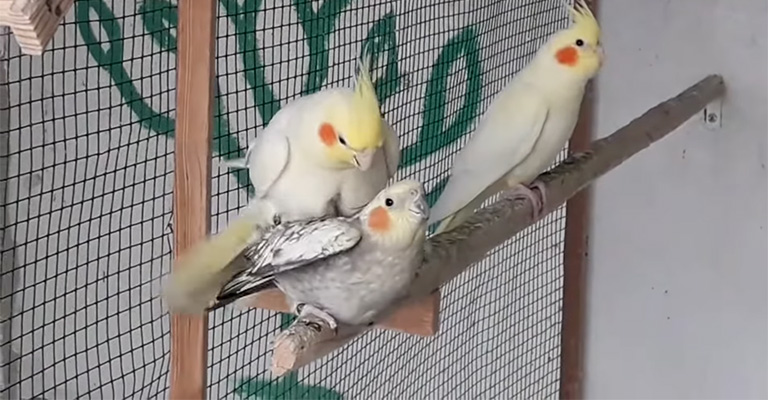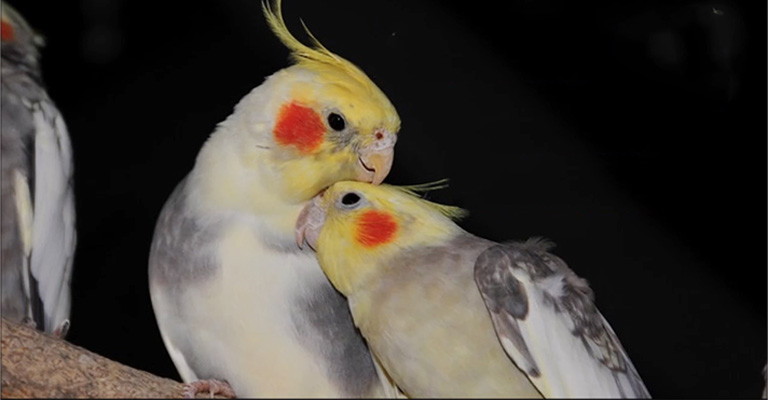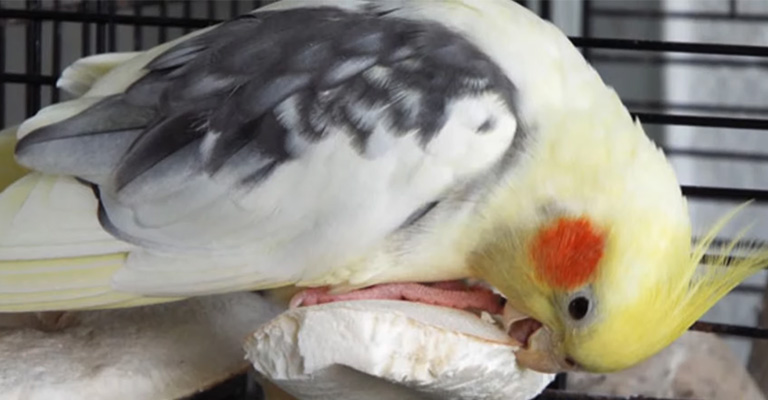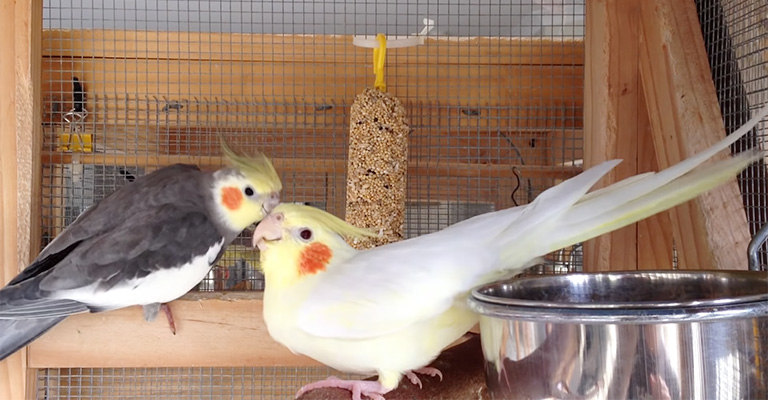Cockatiels are popular pet birds that belong to the parrot family. They are native to Australia and live in flocks in the wild. They are known for their friendly, curious, and playful personalities. They can also be very affectionate and loyal to their owners and mates.
Cockatiels are monogamous birds, which means they mate for life with one partner. They form strong bonds with their mates and display various behaviors to show their affection and readiness for breeding.
This article will explore some common cockatiel mating behaviors and how to understand them.

Cockatiel Mating Behavior- Complete Guide
Here are some signs of mating cockatiels-
Courtship Display
Male cockatiels often display specific behaviors to attract the female’s attention during courtship. This may include bobbing their heads, fluffing their feathers, and performing a “courtship dance” where they strut and walk in a circular pattern. The male may also emit soft chirps or sing to serenade the female.
Nuzzling and Beak Nibbling
Mating cockatiels engage in gentle nuzzling and beak nibbling. The male may approach the female and gently touch her beak or face with his own. This behavior is a sign of affection and bonding between the pair.
Tail Feathers Flaring
When a male cockatiel is in the presence of a female during mating behavior, he may flare his tail feathers. This display showcases his beauty and attracts the female’s attention.
Vertical Crest Position

The cockatiel’s crest, a prominent feature on top of their head, can also indicate mating behavior. During courtship, the male’s crest may be held upright or vertical. This serves as a visual signal to the female, expressing his interest and readiness to mate.
Bowing or Head Banging
A male cockatiel may bow his head forward or bob it up and down in a rhythmic manner as part of his courtship behavior. This action is a way of displaying his intentions and inviting the female to reciprocate the behavior.
Female Acceptance
If a female cockatiel is interested in the male’s advances, she may reciprocate the nuzzling, beak nibbling, and other courtship behaviors. She may also lower her body and lift her wings slightly, indicating her readiness to mate.
Nesting Behavior
Mating behavior often triggers nesting instincts in cockatiels. The female may start exploring the cage or nesting box, inspecting potential nesting sites. She may also engage in activities such as shredding paper, gathering nesting materials, or spending more time in enclosed spaces.
Regurgitation and Feeding Behavior

During mating, the male may regurgitate food for the female as part of their bonding and courtship process. He may offer the regurgitated food by bobbing his head and gently nudging the female. This behavior mimics the act of feeding their potential offspring.
Increased Vocalization
Both male and female cockatiels may become more vocal during mating behavior. They may produce unique calls, chirps, or songs to communicate with each other and reinforce their bond.
Increased Affection and Pair Bonding
Mating behavior in cockatiels is often accompanied by increased affection and pair bonding. The birds may spend more time together, preen each other’s feathers, and seek physical contact through gentle touching or cuddling.
It’s important to note that while these behaviors are typical signs of mating behavior in cockatiels, not all birds may display every behavior, and individual personalities can vary.
Providing a suitable environment with appropriate social interaction, proper nutrition, and veterinary care will help ensure the well-being of your cockatiels.
How to Encourage Cockatiel Mating

Encouraging cockatiel mating requires creating a comfortable and suitable environment for the birds, providing a balanced diet, ensuring the birds are of appropriate age and health, and allowing for natural courtship behaviors.
Here are some steps you can take to encourage cockatiel mating:
Pairing
Ensure you have a male and a female cockatiel of breeding age. Typically, cockatiels reach sexual maturity around 12 to 18 months of age.
Cage setup
Provide a spacious cage with enough room for the birds to move around comfortably. Place a suitable nest box inside the cage.
The nest box should have an entrance hole and be made of bird-safe materials, such as wood. Position the nest box in a quiet and undisturbed area of the cage.
Diet
Offer a well-balanced and nutritious diet to both birds. A varied diet should include high-quality cockatiel pellets, fresh vegetables, fruits, and occasional treats like millet sprays. A healthy diet is essential for their overall well-being and reproductive health.
Lighting
Ensure the birds receive adequate natural light during the day. Exposure to natural sunlight or artificial full-spectrum lighting can help stimulate breeding behavior. Aim for about 10-12 hours of light per day.
Temperature and humidity
Cockatiels prefer a warm and slightly humid environment for breeding. Maintain a comfortable temperature range between 75-85°F (24-29°C) and humidity level around 40-60%.
Bonding
Allow the cockatiels to bond with each other by spending time together in and out of the cage. You can provide opportunities for social interactions, such as allowing them to perch next to each other or providing toys for them to play with together.
Courtship behavior
Observe the birds for natural courtship behaviors. Male cockatiels often display head-bobbing, singing, and showing off their feathers to attract the female’s attention. The female may respond by vocalizing and showing interest in the male’s courtship display.
Nesting material
Provide suitable nesting materials such as wood shavings, shredded paper, or coconut fiber inside the nest box. This will allow the female to build a nest and prepare for breeding.
Privacy
Ensure the birds have privacy during their courtship and breeding period. Minimize disturbances and loud noises around their cage to create a calm and secure environment.
Patience
Breeding may not happen immediately, and it can take time for the cockatiels to establish a bond and go through the breeding process. Be patient and observe their behavior for signs of successful mating, such as the female spending extended periods inside the nest box.
Here Is a Table That Summarizes Some of the Signs of Mating Cockatiels:
| Gender | Behavior | Description |
| Both | Grooming | Cleaning each other’s feathers with their beaks |
| Both | Calling | Making soft or loud sounds to communicate or attract attention |
| Both | Regurgitating | Bringing up food from the crop and feeding it to the mate |
| Male | Brood patch | A bare spot on the chest where feathers fall out to expose skin for incubating eggs |
| Male | Cere color | The fleshy area above the beak that changes color during the breeding season |
| Female | Tail up | Raising the Tail in the air to expose the cloaca or signal interest in mating |
| Male | Wing heart | Lifting the wing tips away from the body to form a heart shape when seen from behind |
| Male | Strutting | Walking around with confidence and swagger to show dominance or attractiveness |
| Male | Beak tapping | Tapping the beak against objects or surfaces to make noise or mark territory |
| Both | Cloacal contact | Rubbing the cloacas together to transfer sperm from male to female |
| Male | Mounting | Climbing on top of the mate and holding on with feet or beaks |
| Female | Rump raise | Lifting the Tail and exposing the cloaca for mating |
| Female | Drooping wings | They lower the wings slightly to indicate readiness or invitation for mating. |
| Male | Displaying | Showing off physical features or movements to impress or entice the mate |
| Female | Eating habits | Eating more or less than usual to prepare for egg laying or feeding chicks |
| Female | Head tilt | Tilting the head back or sideways to signal receptiveness or submission |
FAQ
Female cockatiels usually lay one egg every other day until they have a clutch of 4 to 6 eggs. Depending on their health, diet, and environment, they may lay more or less eggs.
Cockatiels incubate their eggs for about 18 to 21 days. Both male and female cockatiels sit on the eggs and keep them warm.
You can tell if your cockatiel eggs are fertile by candling them. Candling is a method of shining a bright light through the eggshell to see the embryo inside. You can use a flashlight or a candling device for this purpose. You should candle your eggs after 7 to 10 days of incubation. A fertile egg will show red veins or a dark spot inside, while an infertile egg will show nothing or a clear yolk.
Yes, cockatiels mate for life. They form strong bonds with their mates and stay faithful to them. They also share the responsibility of incubating and caring for their eggs and chicks.
Conclusion
Cockatiel mating behavior is fascinating and complex. It involves various physical and vocal cues that indicate their affection and readiness for breeding. Cockatiels are monogamous birds that mate for life with one partner. They also cooperate in incubating and raising their young.
To breed your cockatiels, you must provide them with the conditions and environment to encourage their mating behavior.